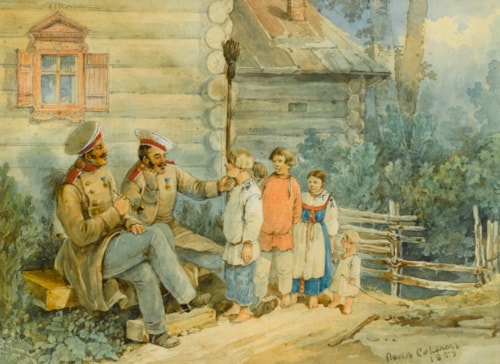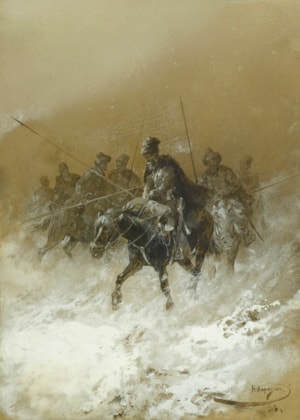enjamin Patersson
(Varberg, Sweden 1748 - St. Petersburg 1815)
The Kamenny Island Palace as seen from Aptekarskii Island
gouache on paper
20.5 × 29.5 cm (8 x 11⅝ in)
In the present work, a copy of Benjamin Patersson’s famous painting in the State Russian Museum, the viewer is presented with a scene of suburban life in an affluent district of St. Petersburg. The view is taken from Aptekarskii Island, from which our eye moves across the still water of the Neva, to Kamenny Island in the background. Stephen Lovell describes the scene thus; ‘The foreground is dominated by a scene of domestic activity on the near shore. Here there are four groups of figures and two distinct narratives. A woman greets or takes leave of a uniformed man at the steps to her family’s residence; and a cabriolet sets off, pursued by a dog and watched by a woman with three children. Both the woman and her children are dressed informally; and the unconstrained domesticity of the scene is emphasized by the uncluttered view of the opposite bank, by the sparse and unsculpted arboreal backdrop, and by the indistinct boundary between road and grass verge.’¹ In the background, on Kamenny Island, two of the most notable residences in St. Petersburg are visible; the Kamennoostrovsky Palace, and the Stroganov Dacha.
Kamenny Island is one of a group of islands in the Neva delta in St. Petersburg. During the nineteenth century the island was notable as one of the most fashionable suburbs of the city, and was the chosen place for much of the Russian royalty and nobility to spend their summers, and as a result grand dachas populate the island.
Kamennoostrovsky Palace was built in the 1770s by Catherine the Great (1729-1796), as a residence for her son Paul I (1754-1801), in the Empress’ favoured neo-Classical style. Set on the south-western promontory of the Kamenny island it had many notable royal residents, including Alexander I (1777-1825), and the deposed Polish king, Stanislaw August Poniatowski (1732-1798). After the palace, the Stroganov dacha was one of the grandest and most recognisable buildings on the island. It was seen as one of hubs of St. Petersburg high society and Count Alexander Sergeyvich Stroganov (1733-1811) would host grand parties there every Sunday, the lavish entertainment costing him 500 rubles a time.²
By the end of the eighteenth century, St. Petersburg had become one of the most beautiful cities and Patersson was at the forefront of the artistic movement to document it. Considered one of the best of the foreign artists working there, he is first mentioned in the city in 1787 and produced his first topographical work in 1793, a theme which would dominate his work for the rest of his. Although there were several landscape painters rendering urban views at the time, their ‘work was somewhat superficial and dry, Paterssen’s [sic] approach to St. Petersburg was essentially lyrical. Paterssen deeply felt the originality of the city and had a way of conveying it in his works.’³ He comprehensively catalogued the city, from the great state buildings, to more suburban views, such as the one in the present work. In fact he painted Kammenny Island and the Stroganov Dacha on more than one occasion (Fig. 1). As Lovell says ‘Paterssen himself was at the forefront of a new trend that emerged at the turn of the century: suddenly artists were not as reluctant to present views of suburban life or to draw such a sharp distinction between city and non-city scenes.’⁴
Patersson’s paintings were widely copied and reproduced, and works such as the present one are testament to his popularity. He remained in St. Petersburg until his death in 1815 and his work has greatly increased our knowledge of ‘the appearance, the life and the ways of the Russian capital of the period’.⁵
¹ Lovell, S., Summerfolk: A History of the Dacha, 1710-2000 (Cornell University Press, Ithaca, 2003), pp.15, 17.
² See E. Amburger, Ingermanland: Eine junge Provinz Rußlands im Wirkungsbereich der Residenz und Weltstadt St. Petersburg-Leningrad, (Cologne, 1980), vol. I, pp.547-548.
³ G. Komelova, G. Printseva and I. Kotelnikova, Petersburg in the Art of Paterssen (Izobrazitelnoye Iskusstvo Publishers, Moscow, 1978), p.23.
⁴ Lovell, p. 15.
⁵ Komelova, p.23.
In the present work, a copy of Benjamin Patersson’s famous painting in the State Russian Museum, the viewer is presented with a scene of suburban life in an affluent district of St. Petersburg. The view is taken from Aptekarskii Island, from which our eye moves across the still water of the Neva, to Kamenny Island in the background. Stephen Lovell describes the scene thus; ‘The foreground is dominated by a scene of domestic activity on the near shore. Here there are four groups of figures and two distinct narratives. A woman greets or takes leave of a uniformed man at the steps to her family’s residence; and a cabriolet sets off, pursued by a dog and watched by a woman with three children. Both the woman and her children are dressed informally; and the unconstrained domesticity of the scene is emphasized by the uncluttered view of the opposite bank, by the sparse and unsculpted arboreal backdrop, and by the indistinct boundary between road and grass verge.’¹ In the background, on Kamenny Island, two of the most notable residences in St. Petersburg are visible; the Kamennoostrovsky Palace, and the Stroganov Dacha.
Kamenny Island is one of a group of islands in the Neva delta in St. Petersburg. During the nineteenth century the island was notable as one of the most fashionable suburbs of the city, and was the chosen place for much of the Russian royalty and nobility to spend their summers, and as a result grand dachas populate the island.
Kamennoostrovsky Palace was built in the 1770s by Catherine the Great (1729-1796), as a residence for her son Paul I (1754-1801), in the Empress’ favoured neo-Classical style. Set on the south-western promontory of the Kamenny island it had many notable royal residents, including Alexander I (1777-1825), and the deposed Polish king, Stanislaw August Poniatowski (1732-1798). After the palace, the Stroganov dacha was one of the grandest and most recognisable buildings on the island. It was seen as one of hubs of St. Petersburg high society and Count Alexander Sergeyvich Stroganov (1733-1811) would host grand parties there every Sunday, the lavish entertainment costing him 500 rubles a time.²
By the end of the eighteenth century, St. Petersburg had become one of the most beautiful cities and Patersson was at the forefront of the artistic movement to document it. Considered one of the best of the foreign artists working there, he is first mentioned in the city in 1787 and produced his first topographical work in 1793, a theme which would dominate his work for the rest of his. Although there were several landscape painters rendering urban views at the time, their ‘work was somewhat superficial and dry, Paterssen’s [sic] approach to St. Petersburg was essentially lyrical. Paterssen deeply felt the originality of the city and had a way of conveying it in his works.’³ He comprehensively catalogued the city, from the great state buildings, to more suburban views, such as the one in the present work. In fact he painted Kammenny Island and the Stroganov Dacha on more than one occasion (Fig. 1). As Lovell says ‘Paterssen himself was at the forefront of a new trend that emerged at the turn of the century: suddenly artists were not as reluctant to present views of suburban life or to draw such a sharp distinction between city and non-city scenes.’⁴
Patersson’s paintings were widely copied and reproduced, and works such as the present one are testament to his popularity. He remained in St. Petersburg until his death in 1815 and his work has greatly increased our knowledge of ‘the appearance, the life and the ways of the Russian capital of the period’.⁵
¹ Lovell, S., Summerfolk: A History of the Dacha, 1710-2000 (Cornell University Press, Ithaca, 2003), pp.15, 17.
² See E. Amburger, Ingermanland: Eine junge Provinz Rußlands im Wirkungsbereich der Residenz und Weltstadt St. Petersburg-Leningrad, (Cologne, 1980), vol. I, pp.547-548.
³ G. Komelova, G. Printseva and I. Kotelnikova, Petersburg in the Art of Paterssen (Izobrazitelnoye Iskusstvo Publishers, Moscow, 1978), p.23.
⁴ Lovell, p. 15.
⁵ Komelova, p.23.





 contact
contact contact
contact +44 20 7313 8040
+44 20 7313 8040









